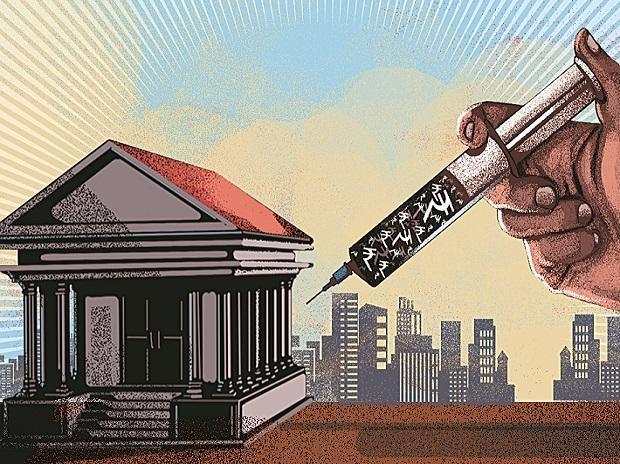Recapitalisation of Banks: Placebo For the NPA Disease?

Image Courtesy: business-standard.com
In a press conference held on Wednesday, Finance Minister Arun Jaitley presented before the media another piece of empty economic policy that has become a hallmark of the Modi-led BJP government. At the press conference, Mr. Jaitley gave out the finer details of the bank recapitalisation plan that he announced with much fanfare in October last year. According to the recapitalisation plan, the public sector banks were to get an infusion of capital worth Rs. 2.11 lakh crores over the next two years. Out of this, a substantial chunk – Rs. 1.35 lakh crore – was to come in the form of recapitalisation bonds and the rest from the government’s budget as well as from the market.
Now Mr. Jaitley says that the banks will get Rs. 88,139 as the first tranche of capital in the 2017-18 fiscal year. Out of this, Rs. 80,000 crore will be in the form of recapitalisation bonds. So far, so good. If we set aside the discussion on whether recapitalisation is really the solution for the banking sector’s problems, there does not seem to be much of a problem with Mr. Jaitley’s plan. But alas, the devil is in the details.
According to Mr. Jaitley’s grand plan, the buyers of the bank recapitalisation bonds are the banks themselves. The banks will invest part of the funds deposited with them to buy the government’s recapitalisation bonds. The government will invest the sale proceeds as capital into the public sector banks. If this sounds convoluted, that is because it is convoluted.
By Mr. Jaitley’s own claim, the main motive of bank recapitalisation was to boost the credit disbursal of the public sector banks to the economy, particularly to the MSME (Micro, Small and Medium Enterprises) sector and agriculture. The banking sector, burdened with bad loans or NPAs – as they are ‘lovingly’ called – which amounted to more than Rs. 8.5 lakh crores, has been tight-fisted with its credit disbursal.
Given the capital adequacy framework that banks were forced to follow by the RBI, they could either get more capital to compensate for the risk of the non-performing assets, or they could shrink their business. In the absence of the former, the banks have been doing the latter. They have been cutting down on credit disbursal. The lack of adequate credit, in turn, has been dragging the economy down.
The way things are at the moment, the NPAs are expected grow even more in the coming years, increasing the need of capital even more. Even at the present level of NPAs, Rs. 2.1 lakh crore is considered inadequate for bank recapitalisation.
Instead of going on this convoluted path of government taking banks’ own money to capitalise them, it would have made more sense if the government simply directed the RBI to go easy on the capital adequacy norms, so that public sector banks could expand their lending to the economy.
After all, these norms are meaningless for the public sector banks. Capital adequacy is meant to reassure the public that a bank is not in danger of collapse. Despite the NPAs and the declining capital adequacy, the Indian public never showed any signs of panic or fear for their deposits in these banks. It is not that the Indian public are ignorant and blind. After all, they did panic and protest when the government tried to introduce the ill-thought out FRDI bill with its bail-in clause and cavalier attitude to depositors’ money, forcing the government to step back. It is because these are government-owned banks with an implicit sovereign guarantee that the public do not dear for their deposits. As long as this implicit guarantee is there, the banks can run on near-zero capital.
What the soap-opera around banking recapitalisation and the FRDI bill directed by Mr. Jaitley hides is the real problem – that the Indian mega corporates had a decade-long party with public savings and now they are refusing to pay back. These defaulting mega corporates and banks loans are the real disease that afflict the banking sector – not the lack of capital. As long as these powerful defaulters are not brought to book, the problem of NPAs will recur, over and over again. No amount of capital infusion is going to cure this. The banks by themselves are helpless. It is the government that frames the laws and it alone has the capacity to change the limited liability clauses that give such impunity to corporate defaulters.
It would have reflected better on Mr. Jaitley if he had begun the new year with an announcement of such a step to prosecute the promoters of these corporates that have defrauded the banking sector. Instead, he has begun 2018 with yet another vacuous announcement.
Get the latest reports & analysis with people's perspective on Protests, movements & deep analytical videos, discussions of the current affairs in your Telegram app. Subscribe to NewsClick's Telegram channel & get Real-Time updates on stories, as they get published on our website.
























